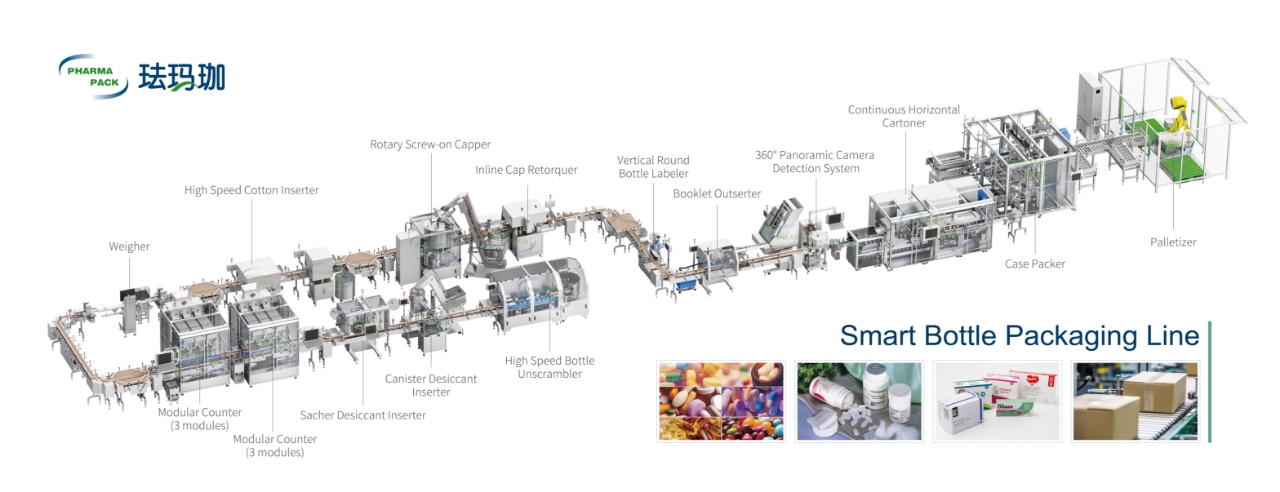

In today’s highly regulated and competitive pharmaceutical landscape, packaging line efficiency is more than a nice-to-have — it’s a critical driver of operational excellence. From blister packs to stick packs and cartons, efficient packaging isn’t just about maximizing throughput. It’s about reducing production costs, ensuring product quality, maintaining regulatory compliance, and staying agile in the face of fluctuating market demands.
With increasing pressure to minimize labor costs, reduce material waste, and adapt swiftly to product variations, pharmaceutical manufacturers are re-evaluating their packaging lines. The need for smarter, leaner, and more responsive operations is clear — and the time to act is now.
In this article, we outline five proven strategies to help pharmaceutical companies enhance packaging efficiency, maintain competitiveness, and prepare for the future of medicine.

Automation is the cornerstone of modern pharmaceutical packaging efficiency. By automating repetitive and precision-dependent tasks — such as counting tablets, filling vials, labeling, sealing, and final inspection — manufacturers can dramatically improve throughput and consistency.
Intelligent systems equipped with machine vision, barcode verification, and AI-powered inspection ensure that every packaged unit meets stringent regulatory standards. These technologies detect defects in real time, reducing the likelihood of recalls and safeguarding brand reputation.
Beyond execution, AI-enabled systems provide real-time insights that enable predictive maintenance, dynamic load balancing, and on-the-fly performance adjustments. These capabilities minimize downtime and support continuous optimization of line operations.
nIncreased throughput and speed
nLower dependency on manual labor
nImproved accuracy and compliance
nReduced error rates and rework
A key step in optimizing any packaging line is understanding it. By mapping the end-to-end packaging flow and analyzing machine data, manufacturers can pinpoint where delays, inefficiencies, or redundancies are occurring.
Advanced analytics tools use historical performance data to identify recurring errors and their root causes — whether that’s an underperforming conveyor, misaligned labeling system, or inconsistent sealing station.
Solving these issues may require a range of interventions: reconfiguring line layouts for better flow, replacing outdated machinery, or redistributing tasks across operators or stations to balance workloads more effectively.
It’s tempting to rely on quick fixes, but long-term efficiency gains come from strategic, data-driven decisions. Investing time in analysis and planning prevents the recurrence of bottlenecks and creates a solid foundation for scalable operations.
Fine-tuning machine parameters and performing regular calibrations ensures that materials — from foils and films to labels and cartons — are used optimally. Misconfigured settings often lead to overuse or misapplication, which increases costs and waste.
Integrated vision systems detect misalignments, print defects, or missing components before they reach the next stage in the line. By catching issues early, manufacturers prevent waste further downstream and maintain consistent product quality.
Efficient material logistics — including climate-controlled storage, automated material feeders, and ergonomic handling practices — reduce spoilage and improve the overall flow of resources.
Reducing material waste not only lowers operational costs but also supports broader environmental goals — a win-win for pharmaceutical companies increasingly held accountable for their ESG performance.
Reactive maintenance may seem cost-effective in the short term, but it often results in costly unplanned downtime. Preventative maintenance, scheduled based on manufacturer guidelines and performance data, keeps lines running smoothly.
IoT-enabled sensors and control systems can continuously monitor equipment condition — temperature, vibration, speed, and more — sending alerts before issues become critical.
Predictive maintenance powered by AI can forecast potential failures based on historical data, allowing maintenance teams to intervene before breakdowns occur. This approach significantly reduces unplanned stoppages and prolongs equipment lifespan.
To make proactive maintenance truly effective, it's important to maintain an inventory of critical spare parts and train personnel to conduct minor repairs quickly and safely.
Today’s pharmaceutical portfolios include everything from standard tablets to personalized therapies. Packaging lines must adapt. Modular machinery enables quick adaptation to various product sizes, shapes, and packaging materials.
Modern packaging systems are designed for speed — and that includes changeovers. Reducing the time required to switch between product formats minimizes downtime and increases agility in scheduling.
With the rise of individualized treatments and small-batch production, flexible packaging capabilities are no longer optional. The ability to swiftly pivot between SKUs or formats is crucial for future-ready operations.
Investing in scalable, configurable systems prepares companies for future shifts in demand, regulation, and innovation — ensuring that today’s packaging lines won’t be tomorrow’s limitations.
Pharmapack offers intelligent automation solutions that span the entire packaging process — from precise tablet counters and AI-enhanced vision systems to high-speed end-of-line packaging equipment. These solutions are engineered for reliability, compliance, and performance.
Whether you're packaging stick packs, bottles, or cartons, Pharmapack’s systems are built for flexibility. Tool-free changeovers and adjustable configurations allow seamless adaptation across formats and production runs.
Intuitive human-machine interfaces (HMIs), minimal change parts, and simplified workflows reduce training time and improve operator confidence. Pharmapack’s equipment is designed to empower teams — not overwhelm them.
From reducing material waste and energy usage to minimizing downtime and repair cycles, Pharmapack technologies contribute directly to lower total cost of ownership and more efficient line performance.
To recap, pharmaceutical manufacturers can significantly enhance packaging line efficiency by implementing:
lIntelligent automation
lStrategic bottleneck elimination
lWaste reduction through precision handling
lProactive maintenance practices
lFlexible, future-proof packaging systems
Each of these strategies contributes not just to smoother operations, but to better product quality, stronger regulatory compliance, and improved ROI. As the pharmaceutical industry continues to evolve, those who invest in smart, adaptable technologies will lead the way.
At Pharmapack, we specialize in helping pharmaceutical manufacturers unlock their packaging line’s full potential. By combining automation, flexibility, and operator-centric design, we enable more efficient, sustainable, and future-ready operations.
Let’s move your packaging forward — smarter, faster, better.